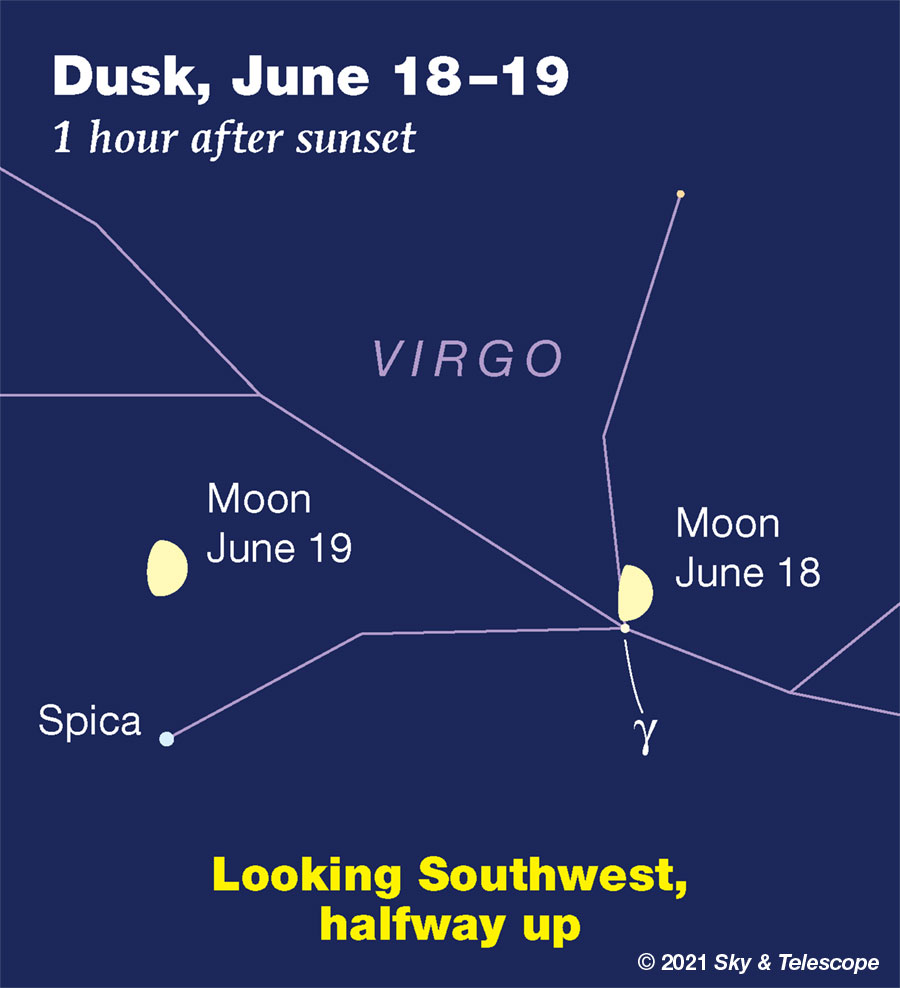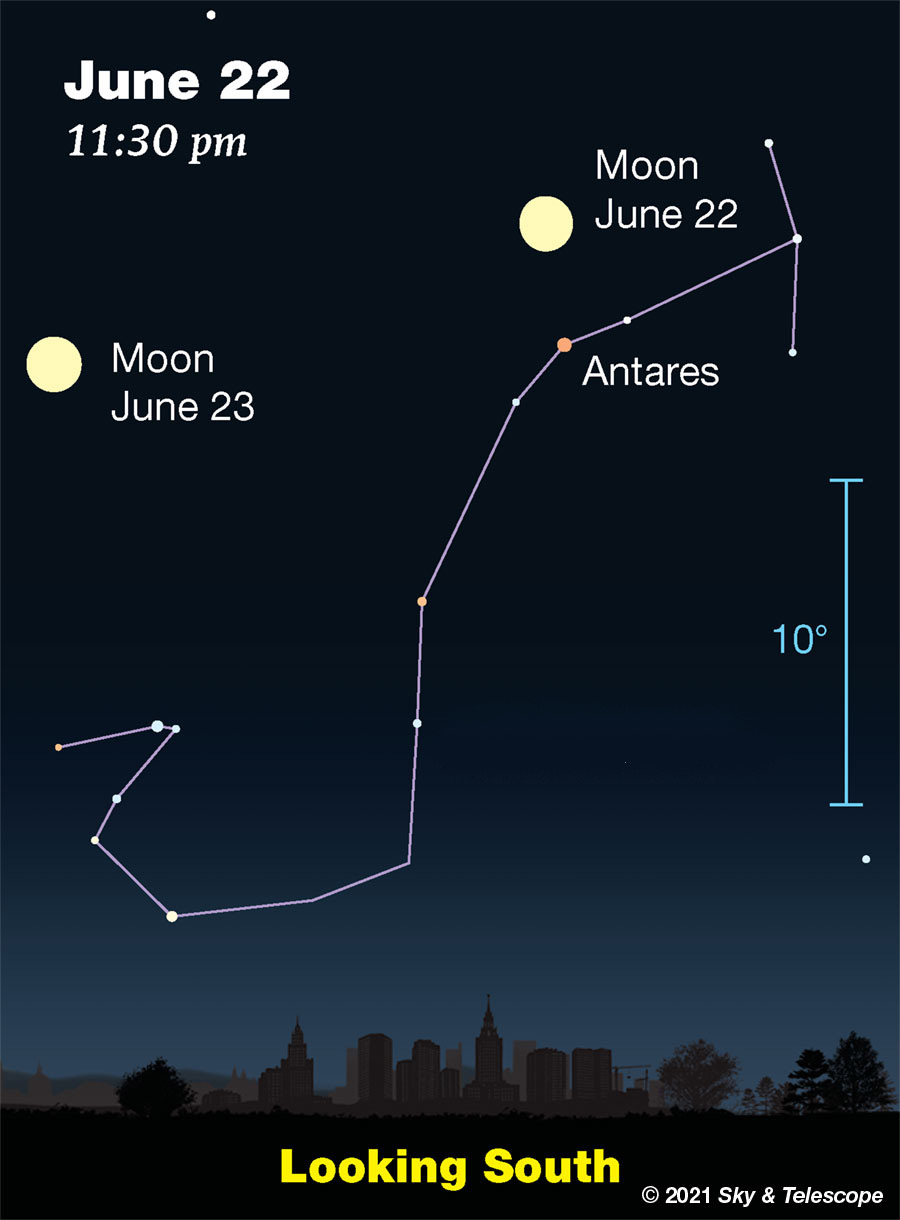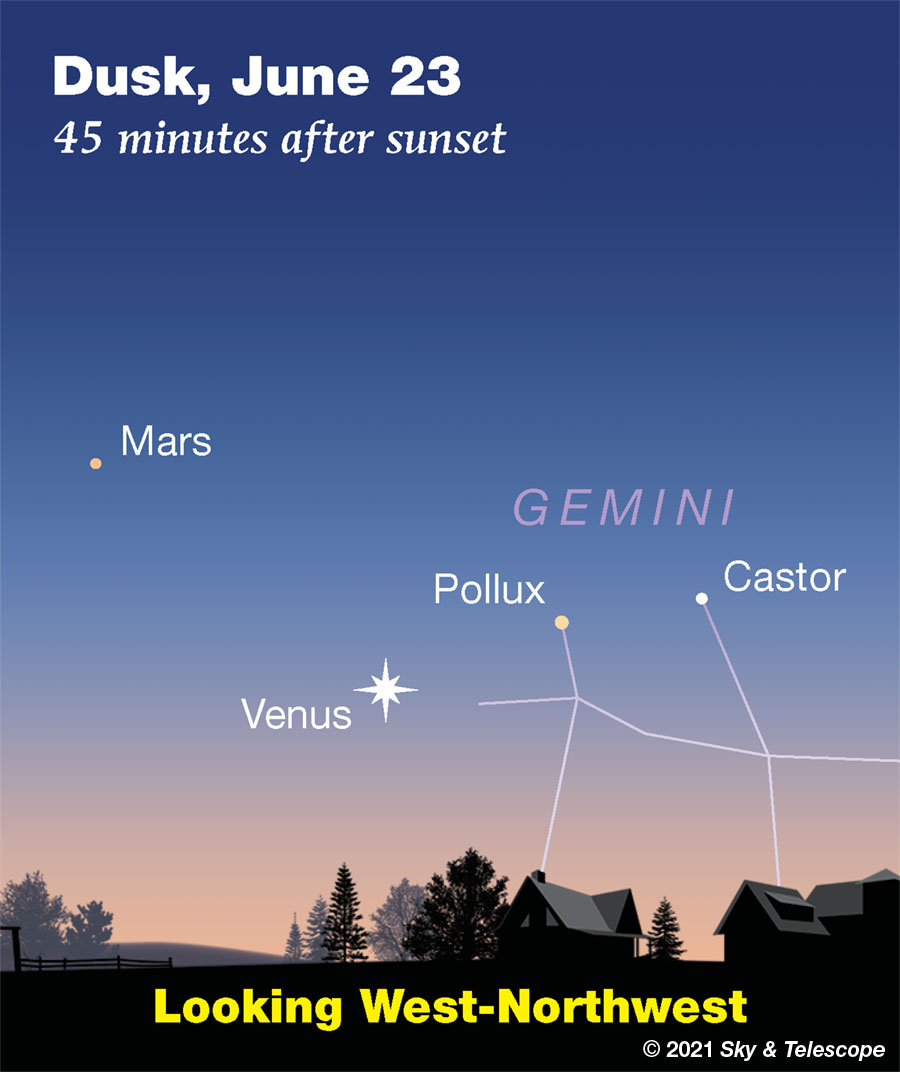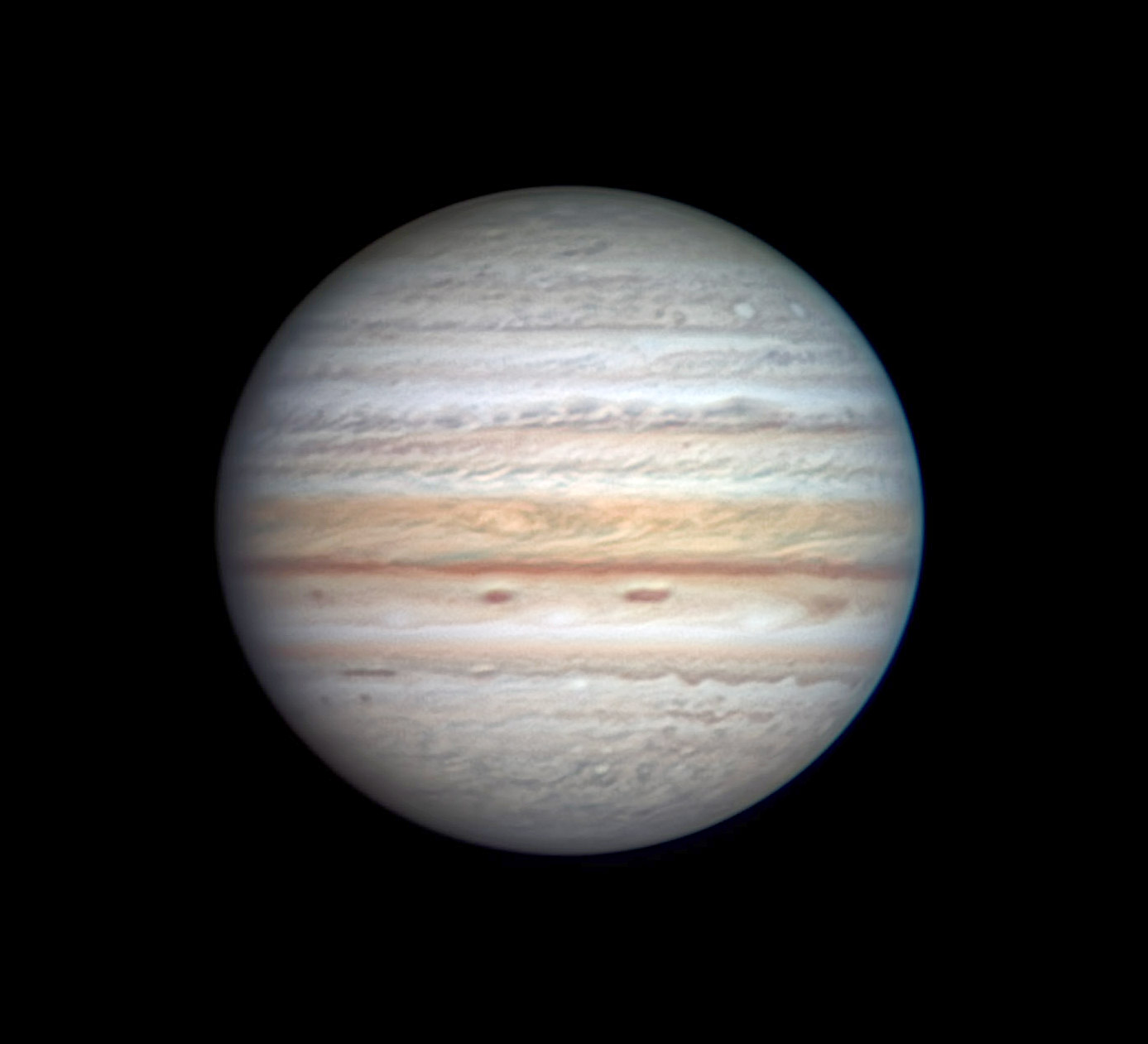Nova Cassiopeiae carries on. It's been three months since Nova Cas 2021 erupted to magnitude 7.7. Surprisingly, it has stayed roughly that bright ever since — except for swelling to 5.3, faint naked-eye visibility, for a week in early-mid May before dropping back to 7.7, then slowly wavering. As of June 24th it was 7.6.
The nova is moderately low in the north-northeast after dark, depending on your latitude. It climbs higher through the night. Charts and comparison stars.
And Nova Herculis. This one leapt up to 6.3 on June 12th, then faded fast. As of June 23rd it was down to 11.6 visually. See Bob King's Bright Nova in Hercules on a Roller Coaster Ride, with charts.
FRIDAY, JUNE 18
■ This evening the Moon shines close to 3rd-magnitude Gamma (γ) Virginis (Porrima), shown below. Gamma Vir is a lovely close, equal-brightness double star for telescopes. Its components are 3.1 arcseconds apart this year and widening slightly year by year. They're both type-F1 stars somewhat larger and hotter than the Sun, shining to us from 39 light-years away.

■ Arcturus is still high overhead at nightfall and Vega shines high in the east, but we're coming into the time of year when these two brightest stars of summer will be about equally high overhead once evening grows late: Arcturus toward the southwest, Vega ever higher in the east.
Arcturus and Vega are 37 and 25 light-years away, respectively. They represent the two commonest types of naked-eye star: a yellow-orange K giant and a white A main-sequence star. They're 150 and 50 times brighter than the Sun, respectively — which, combined with their nearness, is why they dominate among the evening stars.
SATURDAY, JUNE 19
■ Spica (260 light-years away) shines under the Moon, as shown above.
Much higher above them is brighter Arcturus. Spica is pale, icy blue-white. Arcturus is candleflame yellow-orange.
SUNDAY, JUNE 20
■ We pass through the solstice today at 11:32 p.m. EDT. This is when the Sun is farthest north for the year (in Earth's sky) and begins its six-month return southward. Summer officially begins in the Northern Hemisphere, winter in the Southern Hemisphere. For us northerners, this is the year's longest day and shortest night.
It's also the day when (in the north temperate latitudes) the midday Sun passes the closest it ever can to being straight overhead, and thus when your shadow becomes the shortest it can ever be at your location. This happens at your local apparent [solar] noon, which is probably rather far removed from noon in your civil time (clock time).
And if you have a good west-northwest horizon (in mid-northern latitudes), mark carefully where the Sun sets. In a few days you should be able to detect that the Sun is again starting to set a just little south (left) of that point.
MONDAY, JUNE 21
■ After nightfall, look for the Big Dipper hanging straight down high in the northwest. Its bottom two stars, the Pointers, point lower right toward modest Polaris, the end of the Little Dipper's handle.
Examine the middle star of the Big Dipper's handle, Mizar. Can you see its faint little companion Alcor nestled next to it? It's just upper right of Mizar — pointing, as always, the direction from Mizar to Vega.
TUESDAY, JUNE 22
■ The nearly-full Moon shines over Antares this evening. By 11 or midnight they're due south on the meridian, as shown below, meaning that Scorpius is as high as it gets. In addition to Antares, how much else of the constellation can you make out through the moonlight?

WEDNESDAY, JUNE 23
■ Mars is passing through the heart of the Beehive Star Cluster, M44, this evening for North America. Get your binoculars or low-power, wide-field telescope on Mars, very low in the west-northwest, right at the end of dusk. (Faint Mars is about a fist at arm's length upper left of bright Venus.) At the time of dusk at other longitudes around the world, Mars will be more toward one edge of the cluster.

THURSDAY, JUNE 24
■ Full Moon (exact at 2:40 p.m. EDT). The Moon rises in twilight about a half hour after sunset. After dark, you'll see that it's in the edge of the Sagittarius Teapot — if you can see the Teapot's 2nd and 3rd-magnitude stars through the moonlight! Binoculars help. Remember, the Teapot (12° wide) way overspills a binocular's field of view (typically 6° or 8° or so).
FRIDAY, JUNE 25
■ Leo the Lion is mostly a constellation of late winter and spring. But he's not gone yet. As twilight ends look due west, somewhat low, for Regulus, his brightest and now lowest star: the forefoot of the Lion stick figure. The Sickle of Leo extends upper right from Regulus.
The rest of the Lion's constellation figure runs upper left from there for a couple of fist-widths, to his tail star Denebola, the highest. He'll soon be treading offstage into the sunset.
SATURDAY, JUNE 26
■ On the eastern side of the sky, the big Summer Triangle holds sway after dark. Its top star is Vega, the brightest in all the east. The brightest to Vega's lower left is Deneb. Farther to Vega's lower right is Altair. The Milky Way (if you have a dark sky) runs a little inside the Triangle's lower edge.
As evening grows later and even Altair rises high, look left of Altair, by hardly more than a fist, for the compact little constellation Delphinus, the Dolphin.
Did you spot it? Then try for even fainter, smaller Sagitta, the Arrow, to Altair's upper left and just a little closer. The Arrow aims lower left, past the nose of Delphinus.
This Week's Planet Roundup
Mercury hides very low in the glow of dawn.
Venus (magnitude –3.8, in Gemini) shines low in the west-northwest during twilight. It hardly moves now with respect to your landscape from week to week, but its background stars are certainly moving right along. Watch Castor and Pollux, to Venus's right, position themselves to line up with the dazzling planet on June 24th.
Mars (magnitude +1.8, in Cancer) glows very modestly in late twilight low in the west-northwest, upper left of Venus. Mars is about as faint and small as it can ever get, glimmering with only 1/175 of Venus's light. The two planets narrow from 14° apart on June 18th to 10° on the 25th. They'll reach conjunction, ½° apart, on July 12th and 13th.
On the 23rd Mars is smack in front of the delicate Beehive Star Cluster, M44.
Jupiter and Saturn (in Aquarius and Capricornus, respectively) rise in the middle of the night, Jupiter about an hour after Saturn. They shine at their highest and telescopic best in early dawn, a time when the atmospheric seeing often steadies. Jupiter dominates at magnitude –2.5. Saturn, 20° to Jupiter's right, is a more modest +0.5. They'll reach opposition in August.
As dawn begins, look 20° below Jupiter for Fomalhaut, the "Autumn Star." It's emerging from the sunrise glow even before the official start of summer.

The rest of the North Equatorial Belt has faded greatly, except for a very dark red line along its northern edge. (South is up.) Meanwhile the normally bright Equatorial Zone mostly remains a belt-like tan.
Uranus (magnitude 5.8, in Aries) is low in the east just before dawn begins.
Neptune (magnitude 7.9, in Aquarius 20° east of Jupiter) is well up in the southeast before dawn.
All descriptions that relate to your horizon — including the words up, down, right, and left — are written for the world's mid-northern latitudes. Descriptions that also depend on longitude (mainly Moon positions) are for North America.
Eastern Daylight Time, EDT, is Universal Time minus 4 hours. Universal Time is also known as UT, UTC, GMT, or Z time. To become more expert about time systems than 99% of the people you'll ever meet, see our compact article Time and the Amateur Astronomer.
Want to become a better astronomer? Learn your way around the constellations. They're the key to locating everything fainter and deeper to hunt with binoculars or a telescope.
This is an outdoor nature hobby. For an easy-to-use constellation guide covering the whole evening sky, use the big monthly map in the center of each issue of Sky & Telescope, the essential magazine of astronomy.
Once you get a telescope, to put it to good use you'll need a detailed, large-scale sky atlas (set of charts). The basic standard is the Pocket Sky Atlas (in either the original or Jumbo Edition), which shows stars to magnitude 7.6.

Next up is the larger and deeper Sky Atlas 2000.0, plotting stars to magnitude 8.5; nearly three times as many. The next up, once you know your way around, are the even larger Interstellarum atlas (stars to magnitude 9.5) or Uranometria 2000.0 (stars to magnitude 9.75). And be sure to read how to use sky charts with a telescope.
You'll also want a good deep-sky guidebook, such as Sky Atlas 2000.0 Companion by Strong and Sinnott, or the bigger (and illustrated) Night Sky Observer's Guide by Kepple and Sanner.
Can a computerized telescope replace charts? Not for beginners, I don't think, and not on mounts and tripods that are less than top-quality mechanically, meaning heavy and expensive. And as Terence Dickinson and Alan Dyer say in their Backyard Astronomer's Guide, "A full appreciation of the universe cannot come without developing the skills to find things in the sky and understanding how the sky works. This knowledge comes only by spending time under the stars with star maps in hand."
![]() Audio sky tour. Out under the evening sky with your
Audio sky tour. Out under the evening sky with your
earbuds in place, listen to Kelly Beatty's monthly
podcast tour of the heavens above. It's free.
"The dangers of not thinking clearly are much greater now than ever before. It's not that there's something new in our way of thinking, it's that credulous and confused thinking can be much more lethal in ways it was never before."
— Carl Sagan, 1996
"Facts are stubborn things."
— John Adams, 1770
 7
7









Comments
Rod
June 18, 2021 at 1:52 pm
I did some Cygnus observing late Wednesday night and early Thursday morning. 10-inch with low power, wide field view 2-inch eyepiece at 34x, very enjoyable stars, clusters, asterisms and Albireo, gold-blue double star. This morning I viewed sunspot AR2833, larger than Earth size using my 90-mm refractor with glass, white light solar filter at 53x. Spaceweather.com reported this was old sunspot AR2824 that rotated around the Sun and back into view with a new number. I viewed that sunspot back on 22 and 27 of May and now seeing it again, still larger than Earth size but with a new number 🙂 I was able to view some of the sunrise solar eclipse too on 10-June. Posted report notes at Bob King's reports. So far, June is a pretty good month for observing 🙂
You must be logged in to post a comment.
mary beth
June 19, 2021 at 12:25 pm
Hi Rod! Glad June has been clear and profitable for you. Albireo sounds beautiful! I’m trying to figure out what temperature range a star that color would be classified. Did the sunspot get a new number because they did not realize initially that it was the same one?
You must be logged in to post a comment.
Rod
June 20, 2021 at 8:22 am
mary beth, spaceweather.com reports tradition for renumbering the old sunspots that reappear. Grid location and other properties show they are the same. My 14-June observations notes from spaceweather.com states "Old sunspot AR2824 is returning after two weeks on the far side of the sun. Per tradition, it is being renumbered as AR2833. Credit: SDO/HMI”. My 18 June observation notes states. [Observed 0900-0940 EDT/1300-1340 UT. "Daily Sun: 18 Jun 21, Sunspot AR2833 remains stable and quiet. Strong solar flares are unlikely today. Credit: SDO/HMI” I viewed using TeleVue 19-mm WF eyepiece with glass, white light solar filter and Celestron #12 Yellow filter. The Sun’s distance near 1.016 au. At 53x, the telescope view resolved ~ 4200 km diameter on the Sun, 5.7 arcsecond angular size. Earth size ~ 17.3 arcsecond. AR2833 is larger than earth size. 1 arcminute angular size ~ 44,213 km diameter on the Sun. Sun’s angular size ~ 31.48 arcminute. Telescope FOV ~ 74 arcminute in the eyepiece. 17-year cicada loud in the trees. See the .pptx slides updated with current skylive.com view of the Sun and spaceweather.com. The scale shows AR2833 is larger than Earth size. I estimate at least 20 arcsecond size or larger. AR2833 was large dark core with lighter area around it and plage. A couple of much smaller dark areas visible too near the core of AR2833 and lighter areas surrounding AR2833." Concerning Albireo, this is a favorite of many telescope users to see, https://en.wikipedia.org/wiki/Albireo
You must be logged in to post a comment.
Bob-dBouncier
June 19, 2021 at 5:24 pm
"Honey Moon" is new to me (outside of weddings). June's moon was either 'strawberry' or 'rose'.
You must be logged in to post a comment.
mary beth
June 24, 2021 at 6:35 pm
A rose by any other name LOL!
The moon looked full to me by Tuesday night. There must not be much difference in percentage each night. Enjoy!
You must be logged in to post a comment.
Rod
June 23, 2021 at 7:23 am
mary beth, New Jersey Eclipse Fan. Some very enjoyable viewing this morning, clear and cool with temp 11C. Jupiter looks good at 200x, Saturn too. Here is my observation report and sky chart slides. Europa moon at Jupiter began a shadow transit at 0400 EDT. Reminded me of the Muppet's Treasure Island movie. *The black spot*
[Observed 0330-0500 EDT/0730-0900 UT. Sunrise 0542 EDT/0942 UT. Full Moon 24-June-2021 at 1840 UT. Waxing gibbous Moon low in SW this morning in Ophiuchus. Very enjoyable views of Jupiter and Saturn. Europa shadow transit began 0800 UT or 0400 EDT. I was able to see the tiny black spot at 200x using Celestron #58 Green filter. Using Celestron #12 Yellow filter, Saturn lovely with some cloud bands visible and Cassini division. Titan and Rhea moons visible. I viewed until 0500 EDT, sky glow lighting up the eastern horizon as sunrise approaching. Lovely cool morning with temperature 11C and
NW winds 5 knots. An owl hooted in the woods while I viewed. The 17-year cicada are just about all gone. In the evenings, fireflies are out in the fields and pastures. This morning I used the TeleVue 9-mm Nagler and TeleVue 1.8x Barlow lens for 200x viewing. Jupiter is
looking good at 200x now, many cloud bands visible using the green filter, more than the yellow filter views. The XT10i will do even better job looking at Jupiter, Saturn too. I could see Theta Capricorni near Saturn with unaided eyes. Saturn retrograde motion moving away from Theta Capricorni star. This morning the angular separation according to Starry Night Pro Plus 8, 1 degree, 22 arcminute, 34 arcseconds.]
You must be logged in to post a comment.
mary beth
June 24, 2021 at 6:45 pm
Wow Rod, that sounds like an unusually cool and clear summer night. Thank you for the excellent description. I hope it’s still nice weather for everyone to see the full strawberry moon. It’s been mostly cloudy here during the day, but has been clearing off right before sunset fortunately. Even with the almost full Moon nearby, Antares was so bright, I was surprised it was not more washed out by the bright moon. Heavy layers of stratus clouds that were in the northwest separated just long enough for us to get a short view of beautiful Venus. No owls but a few nightingales, bats and a couple of herons added to the scenery. We live pretty close to a major airport so lots of sky traffic all around.
You must be logged in to post a comment.
You must be logged in to post a comment.